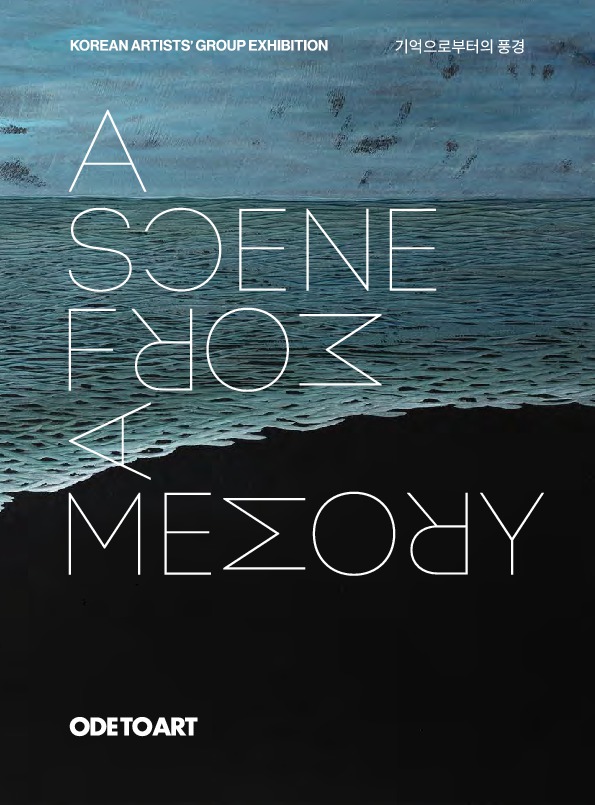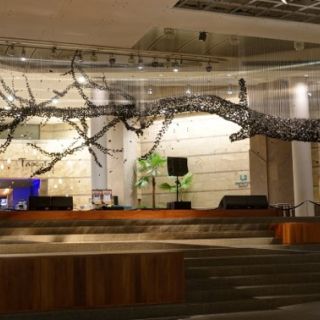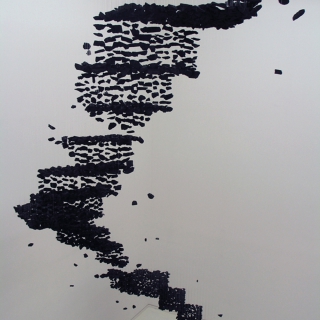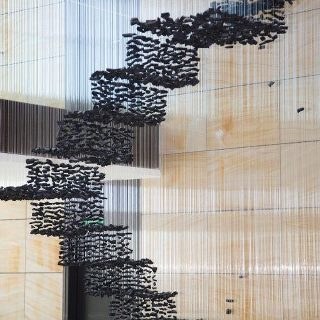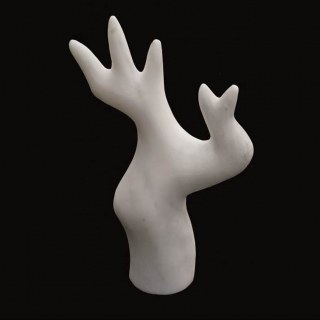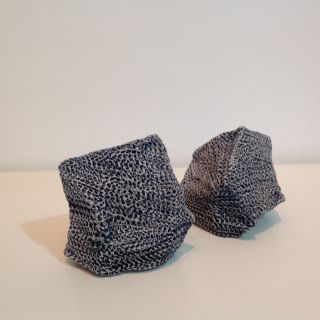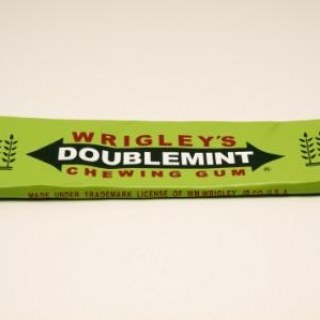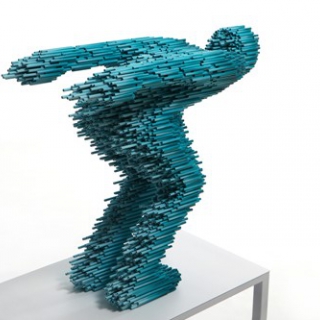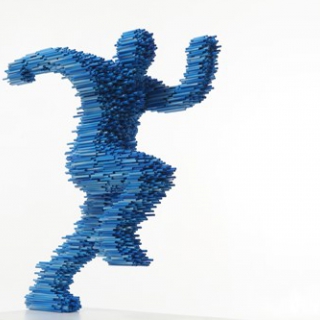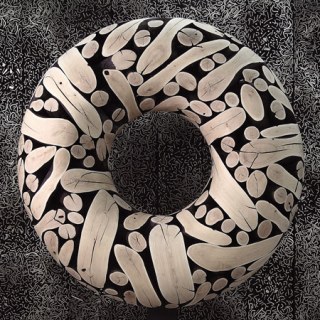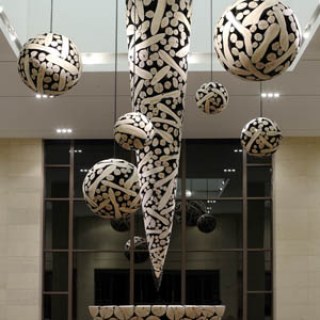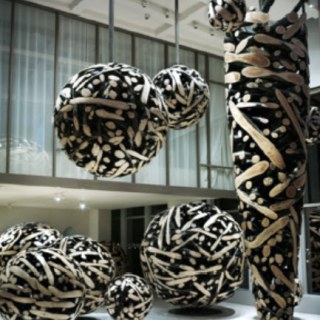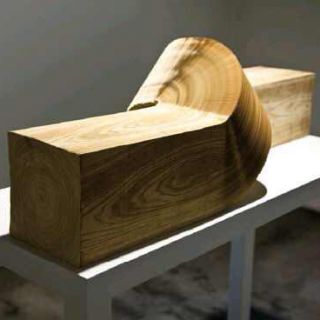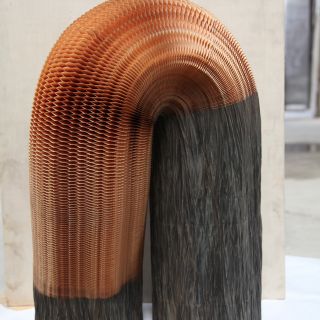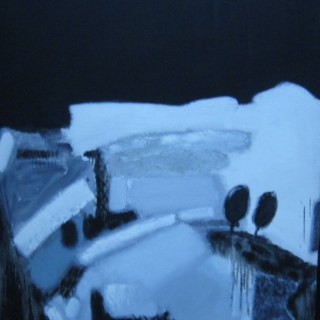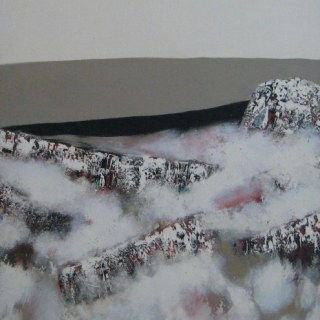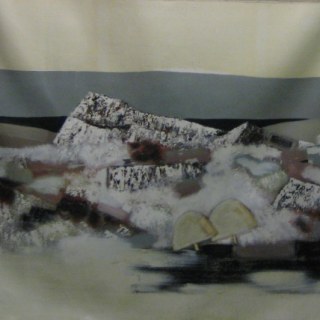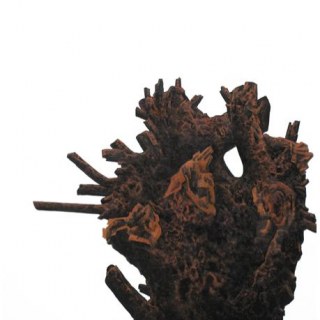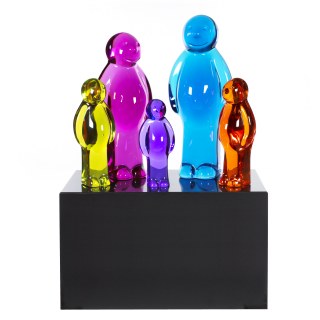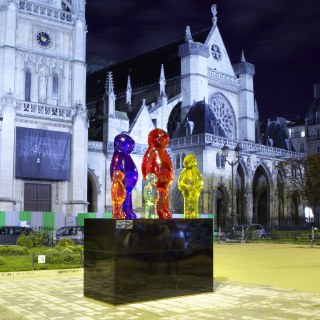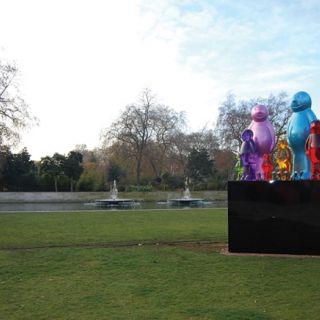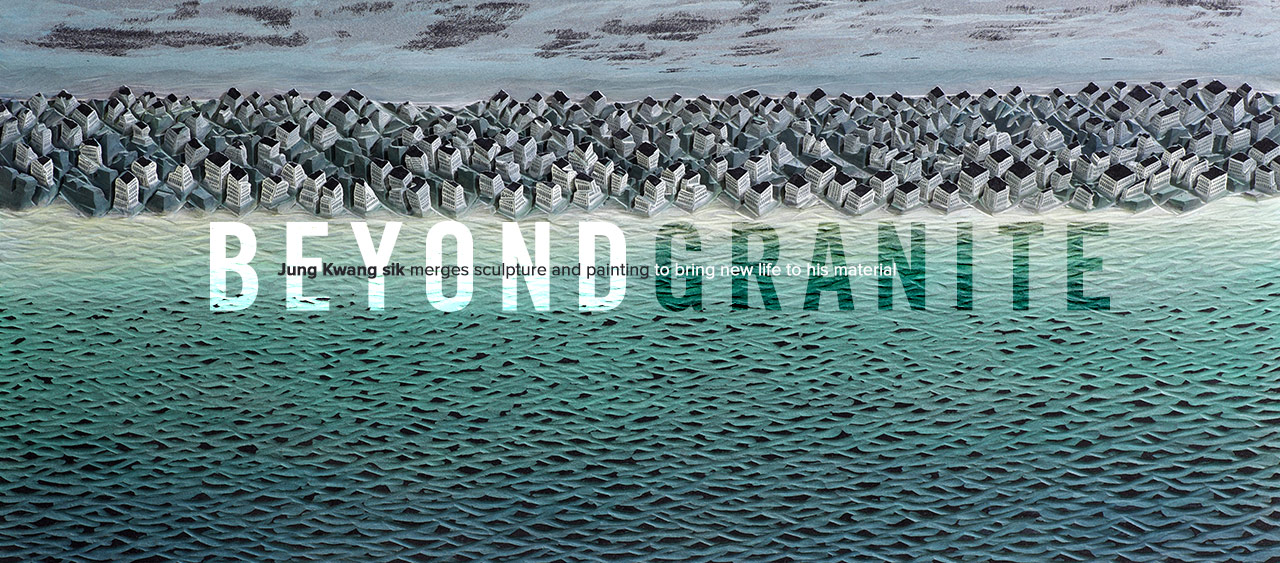
Internationally recognized for his masterful fusion
of painting and sculpture, South Korean artist Jung Kwang Sik graduated in 1992
with a Stage Design major from Carrara Academy, Italy, later receiving his
BFA from Hong-lk University in 1996. Utilizing beds of carved and scratched
granite, which he then paints, his works suggest sweeping landscapes viewed
from an aerial perspective. His exceptional skill of carving, scratching and
painting creates a vision of landscapes as one might see them from 30,000 feet,
materialized in trails of crustal movements, the swelling and contraction of
the earth, and the etched beauty of erosion. The resulting visual field is majestic and unforgettable.
Viewing 1 works by Jung Kwang Sik
Sort
Videos 
Videos
Biography 
Biography
Internationally recognized for his masterful fusion of painting and sculpture, South Korean artist Jung Kwang Sik graduated in 1992 with a Stage Design major from Carrara Academy, Italy, later receiving his BFA from Hong-lk University in 1996. He currently lives in South Korea. Utilizing beds of carved and scratched granite, which he then paints, the artist's works suggest sweeping landscapes viewed from an aerial perspective. Creating extraordinarily detailed depictions of lush countrysides and serene coastlines, Sik's gift for sculpting vivid, three-dimensional vistas alludes to his background in stage design.
The grinding work involved in the creation of Sik's works sometimes places limitations on his direction and often results in the achievement of hexagonal patterns. The addition of paint to the crowns of these hexagons lends an architectural element to his pieces, emblematic of cities, villages and roads,with his exceptional skill of carving, scratching and painting creating a complete and fluid vision of landscapes as one might see them from 30,000 feet.
Jung's scenery does not represent a specific geographical location or any one culture. The images arise from within his mind and become materialized in trails of crustal movements, the swelling and contraction of the earth and the etched beauty of erosion. The visual field is majestic and dynamic and his brilliant use of color, light and shape keenly capture the motion of water and wind in nature. There is at once a visual tension and an induced tranquility brought on by the undulations of seeming waves of density and dispersion and high-low pitch. Jung has expressed the desire to capture the ebb and flow, the eternal and the universal rhythm of the relationship between man and our world.
Collections
Aley Sculpture Park, Lebanon
Bucheckmese Sculpture Park, Istanbul, Turkey
Chang-a building, Seoul
Expo Sculpture Park, Icheon
Gyonggi Museum of Modern Art, Ansan
National Museum of Contemporary Art (Artbank), Kwa-chon
Ssol Beach Resort, Yangyang City, Korea
Swiss Private Bank
Youngrang Lake, Sokcho, Gangwon Province
The grinding work involved in the creation of Sik's works sometimes places limitations on his direction and often results in the achievement of hexagonal patterns. The addition of paint to the crowns of these hexagons lends an architectural element to his pieces, emblematic of cities, villages and roads,with his exceptional skill of carving, scratching and painting creating a complete and fluid vision of landscapes as one might see them from 30,000 feet.
Jung's scenery does not represent a specific geographical location or any one culture. The images arise from within his mind and become materialized in trails of crustal movements, the swelling and contraction of the earth and the etched beauty of erosion. The visual field is majestic and dynamic and his brilliant use of color, light and shape keenly capture the motion of water and wind in nature. There is at once a visual tension and an induced tranquility brought on by the undulations of seeming waves of density and dispersion and high-low pitch. Jung has expressed the desire to capture the ebb and flow, the eternal and the universal rhythm of the relationship between man and our world.
Collections
Aley Sculpture Park, Lebanon
Bucheckmese Sculpture Park, Istanbul, Turkey
Chang-a building, Seoul
Expo Sculpture Park, Icheon
Gyonggi Museum of Modern Art, Ansan
National Museum of Contemporary Art (Artbank), Kwa-chon
Ssol Beach Resort, Yangyang City, Korea
Swiss Private Bank
Youngrang Lake, Sokcho, Gangwon Province
Exhibitions 
Exhibitions
2013
Bill Lowe Gallery, Atlanta, GA, USA
2011
Nampo Art Museum, Goheung, Korea (July)
Ponetive Space, Paju, Heiry, Korea (September)
2010
Healing Scenery II, Gallery Jak, Korea
VIEW, Insa Art Center, Seoul, Korea
2009
City of Imagination, Sol Beach Gallery
Healing Scenery, Gallery Jak
VIEW Insa Art Center, Seoul, Korea
2007
Ponetive Space, Paju, Heiry, Korea
2005
Gallery On, Seoul, Korea
2001
Sungbo Gallery, Korea
1998
Insa Gallery, Korea
Bill Lowe Gallery, Atlanta, GA, USA
2011
Nampo Art Museum, Goheung, Korea (July)
Ponetive Space, Paju, Heiry, Korea (September)
2010
Healing Scenery II, Gallery Jak, Korea
VIEW, Insa Art Center, Seoul, Korea
2009
City of Imagination, Sol Beach Gallery
Healing Scenery, Gallery Jak
VIEW Insa Art Center, Seoul, Korea
2007
Ponetive Space, Paju, Heiry, Korea
2005
Gallery On, Seoul, Korea
2001
Sungbo Gallery, Korea
1998
Insa Gallery, Korea
Critique 
Critique
Scenery Sculpture, Scenery of Mind Expressed
by Sculpture
by Choi, Taeman (Art Critic)
There exists a peacefully flowing river across a frame, a widespread field and a mountain powerfully winding in and out in Jung Kwang Sik’s work. When you come close to the work you notice an artificial city with dense buildings which reminds you of landscapes seen from a bird’s-eye view. Although his works are not drawings, but sculpture of stone, they contain the character of a painting. The texture made by using the grinder reminds us of the ground and with the grinder he is able to materialise trails of crustal movement, rising and erosion on the stone plates. They resemble the surface of the earth or moving waves. His works personify scenery and that’s why his works remind you of natural scenery when you look at them. If the stone plates were not coloured, they could resemble landscapes before the world began. His works have evolved from abstract works to scenery. In his abstract works, which are cubes with uneven fringes, texture overwhelms the cubes.
His works have uneven surfaces which means they are sculptures in relief. With colours layered on top of the scratches, they very closely resemble paintings. Grinding work has a limitation in terms of direction and it usually only results in regular hexahedron shapes. Jung’s works represent architecture as they add colours to the tilted small hexahedrons which appear as cities, villages, and roads. This enhances the nature of paintings in the works. Riverside houses packed close to each other look like European cities rather than Korean ones, or look like construction on deserted highland. However, it should be noted that his scenery does not represent a particular region. Rather, his scenes are images which are created in his mind. The scenery is always shown from a distance and far from human subjects, one can discern his attitude of contemplation.
Why does he focus on the scenery sculpture? The answer is that he wants to create works that are similar to a stage set. Interestingly, he majored in stage arts in Italy. His experience with stage arts definitely affects the perspective of looking at the objects and works around him.
Upon closer inspection of his work, you come into contact with their surfaces. Visual tension and relaxation that are present in his works add to aesthetic character as density-dispersion, high-low pitch and stress result in aesthetic effects.
In conclusion, his work are all-over reliefs containing paintings of nature as they are full of texture. He attempts to let the viewer experience the surfaces of the materials through touch and creates huge landscape scenes using fine cracks.
by Choi, Taeman (Art Critic)
There exists a peacefully flowing river across a frame, a widespread field and a mountain powerfully winding in and out in Jung Kwang Sik’s work. When you come close to the work you notice an artificial city with dense buildings which reminds you of landscapes seen from a bird’s-eye view. Although his works are not drawings, but sculpture of stone, they contain the character of a painting. The texture made by using the grinder reminds us of the ground and with the grinder he is able to materialise trails of crustal movement, rising and erosion on the stone plates. They resemble the surface of the earth or moving waves. His works personify scenery and that’s why his works remind you of natural scenery when you look at them. If the stone plates were not coloured, they could resemble landscapes before the world began. His works have evolved from abstract works to scenery. In his abstract works, which are cubes with uneven fringes, texture overwhelms the cubes.
His works have uneven surfaces which means they are sculptures in relief. With colours layered on top of the scratches, they very closely resemble paintings. Grinding work has a limitation in terms of direction and it usually only results in regular hexahedron shapes. Jung’s works represent architecture as they add colours to the tilted small hexahedrons which appear as cities, villages, and roads. This enhances the nature of paintings in the works. Riverside houses packed close to each other look like European cities rather than Korean ones, or look like construction on deserted highland. However, it should be noted that his scenery does not represent a particular region. Rather, his scenes are images which are created in his mind. The scenery is always shown from a distance and far from human subjects, one can discern his attitude of contemplation.
Why does he focus on the scenery sculpture? The answer is that he wants to create works that are similar to a stage set. Interestingly, he majored in stage arts in Italy. His experience with stage arts definitely affects the perspective of looking at the objects and works around him.
Upon closer inspection of his work, you come into contact with their surfaces. Visual tension and relaxation that are present in his works add to aesthetic character as density-dispersion, high-low pitch and stress result in aesthetic effects.
In conclusion, his work are all-over reliefs containing paintings of nature as they are full of texture. He attempts to let the viewer experience the surfaces of the materials through touch and creates huge landscape scenes using fine cracks.

Stay connected.
Sign up to our newsletter for updates on new arrivals and exhibitions



